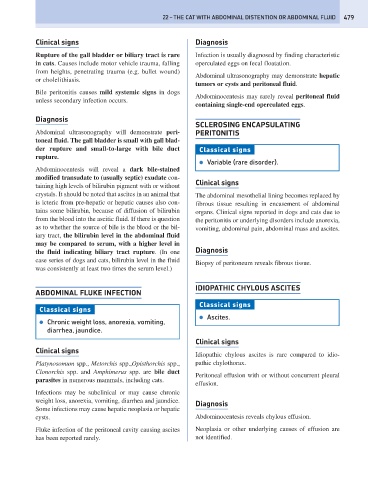Page 487 - Problem-Based Feline Medicine
P. 487
22 – THE CAT WITH ABDOMINAL DISTENTION OR ABDOMINAL FLUID 479
Clinical signs Diagnosis
Rupture of the gall bladder or biliary tract is rare Infection is usually diagnosed by finding characteristic
in cats. Causes include motor vehicle trauma, falling operculated eggs on fecal floatation.
from heights, penetrating trauma (e.g. bullet wound)
Abdominal ultrasonography may demonstrate hepatic
or cholelithiasis.
tumors or cysts and peritoneal fluid.
Bile peritonitis causes mild systemic signs in dogs
Abdominocentesis may rarely reveal peritoneal fluid
unless secondary infection occurs.
containing single-end operculated eggs.
Diagnosis
SCLEROSING ENCAPSULATING
Abdominal ultrasonography will demonstrate peri- PERITONITIS
toneal fluid. The gall bladder is small with gall blad-
der rupture and small-to-large with bile duct Classical signs
rupture.
● Variable (rare disorder).
Abdominocentesis will reveal a dark bile-stained
modified transudate to (usually septic) exudate con-
taining high levels of bilirubin pigment with or without Clinical signs
crystals. It should be noted that ascites in an animal that The abdominal mesothelial lining becomes replaced by
is icteric from pre-hepatic or hepatic causes also con- fibrous tissue resulting in encasement of abdominal
tains some bilirubin, because of diffusion of bilirubin organs. Clinical signs reported in dogs and cats due to
from the blood into the ascitic fluid. If there is question the peritonitis or underlying disorders include anorexia,
as to whether the source of bile is the blood or the bil- vomiting, abdominal pain, abdominal mass and ascites.
iary tract, the bilirubin level in the abdominal fluid
may be compared to serum, with a higher level in
the fluid indicating biliary tract rupture. (In one Diagnosis
case series of dogs and cats, bilirubin level in the fluid
Biopsy of peritoneum reveals fibrous tissue.
was consistently at least two times the serum level.)
IDIOPATHIC CHYLOUS ASCITES
ABDOMINAL FLUKE INFECTION
Classical signs
Classical signs
● Ascites.
● Chronic weight loss, anorexia, vomiting,
diarrhea, jaundice.
Clinical signs
Clinical signs
Idiopathic chylous ascites is rare compared to idio-
Platynosomum spp., Metorchis spp.,Opisthorchis spp., pathic chylothorax.
Clonorchis spp. and Amphimerus spp. are bile duct
Peritoneal effusion with or without concurrent pleural
parasites in numerous mammals, including cats.
effusion.
Infections may be subclinical or may cause chronic
weight loss, anorexia, vomiting, diarrhea and jaundice. Diagnosis
Some infections may cause hepatic neoplasia or hepatic
cysts. Abdominocentesis reveals chylous effusion.
Fluke infection of the peritoneal cavity causing ascites Neoplasia or other underlying causes of effusion are
has been reported rarely. not identified.

